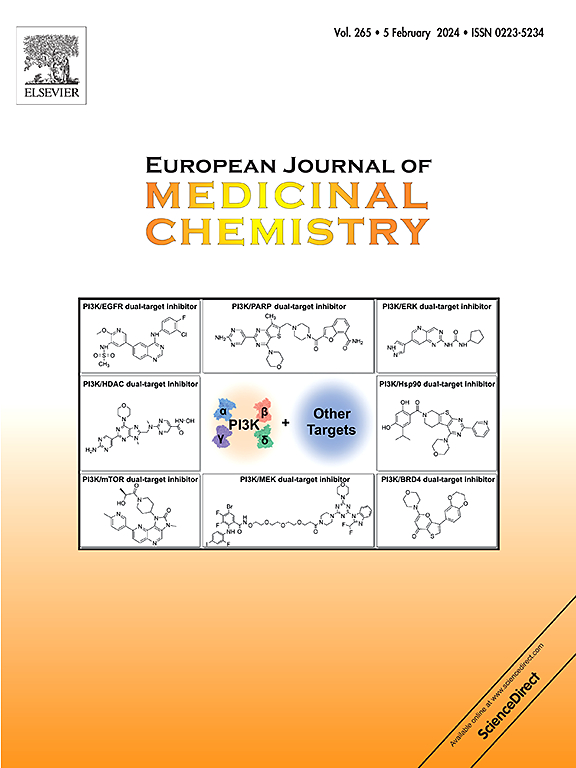Discovery of hybrids of bisbibenzyl with furoxan as lysosomotropic agents for the treatment of drug-resistant non-small-cell lung cancer
IF 6
2区 医学
Q1 CHEMISTRY, MEDICINAL
引用次数: 0
Abstract
Twenty-one novel macrocyclic bisbibenzyl-furoxan hybrids were designed and synthesized as lysosomotropic agents, with subsequent evaluation of their anticancer potential against multidrug-resistant (A549/Taxol, MCF-7/ADR) and parental (A549, MDA-MB-231, MCF-7) cancer cell lines. Compound 15a emerged as the most promising candidate, demonstrating potent antiproliferative activity against paclitaxel-resistant A549/Taxol cells (IC50 = 0.87 μM) with good selectivity over normal cells. Structure-activity relationship studies established a positive correlation between pKa values of the hybrids and their cytotoxic potency against A549/Taxol cells. Mechanistic investigations revealed that the basic nature of 15a facilitated its selective accumulation in acidic lysosomes of drug-resistant cells, where it triggered substantial nitric oxide (NO) release and reactive oxygen species (ROS) generation. This further induced lysosomal membrane permeabilization and subsequent cell apoptosis. Notably, 15a displayed superior in vivo antitumor efficacy in A549/Taxol xenograft models compared to paclitaxel, without observable systemic toxicity. This work establishes that strategic hybridization of basic bisbibenzyl scaffolds with nitric oxide-donating furoxan moieties represents an effective lysosome-targeting approach to overcome multidrug resistance in cancer therapy.


双苯并与呋喃嘧啶杂交体治疗耐药非小细胞肺癌的研究
设计并合成了21种新型大环双苯并呋喃嘧啶杂合物作为促溶体药物,随后对其对多药耐药(A549/Taxol, MCF-7/ADR)和亲本(A549, MDA-MB-231, MCF-7)癌细胞的抗癌潜力进行了评价。化合物15a对紫杉醇耐药A549/Taxol细胞(IC50 = 0.87 μM)表现出较强的抗增殖活性,对正常细胞具有较好的选择性。构效关系研究表明,杂种pKa值与其对A549/Taxol细胞的毒力呈正相关。机制研究表明,15a的基本性质有助于其在耐药细胞的酸性溶酶体中选择性积累,从而引发大量一氧化氮(NO)的释放和活性氧(ROS)的产生。这进一步诱导溶酶体膜渗透和随后的细胞凋亡。值得注意的是,与紫杉醇相比,15a在A549/紫杉醇异种移植模型中显示出更好的体内抗肿瘤功效,没有明显的全身毒性。这项工作表明,碱性双苯基支架与一氧化氮供体呋喃嘧啶部分的战略性杂交代表了一种有效的溶酶体靶向方法,可以克服癌症治疗中的多药耐药。
本文章由计算机程序翻译,如有差异,请以英文原文为准。
求助全文
约1分钟内获得全文
求助全文
来源期刊
CiteScore
11.70
自引率
9.00%
发文量
863
审稿时长
29 days
期刊介绍:
The European Journal of Medicinal Chemistry is a global journal that publishes studies on all aspects of medicinal chemistry. It provides a medium for publication of original papers and also welcomes critical review papers.
A typical paper would report on the organic synthesis, characterization and pharmacological evaluation of compounds. Other topics of interest are drug design, QSAR, molecular modeling, drug-receptor interactions, molecular aspects of drug metabolism, prodrug synthesis and drug targeting. The journal expects manuscripts to present the rational for a study, provide insight into the design of compounds or understanding of mechanism, or clarify the targets.

 求助内容:
求助内容: 应助结果提醒方式:
应助结果提醒方式:


